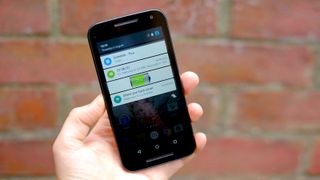Why you can trust TechRadar
While both phones have the same Snapdragon 410 CPU, the 8GB version has 1GB RAM and the 16GB version 2GB.
Here's a bit I need to stress: there are palpable performance benefits to the 2GB version. You'll feel them throughout the interface, but obvious examples include a smoother camera preview, less time for apps to load when the phone is doing other tasks, and fewer disjointed transitions when the phone is 'catching up' with itself.
There's none of this in the 1GB Moto G. Its performance is charmingly smooth, but there is mild creakiness. Tellingly, though, it's nothing like the performance hit I've heard from multiple first-hand sources and experienced myself in older Moto Gs since the move to Android Lollipop.

To put it bluntly, many old Moto Gs are slow these days. Is it planned obsolescence? Or are the older phones simply unable to keep up with the new Google software?
There are reasons to believe both stories. On the cynical, "Motorola is desperate for us to upgrade so it has killed the old Moto Gs" front, the Snapdragon 410 CPU used in the new model isn't much more powerful than the Snapdragon 400 used in 2013's Moto Gs.
Both are quad-core 1.2GHz chipsets with modest Adreno GPUs that won't challenge top-end mobile CPUs from the past few years. The difference is that where the Snapdragon 400 uses 32-bit Cortex-A7 cores, the Snapdragon 410 uses native 64-bit Cortex-A53 ones.
These are from the same family of cores used in top-end Snapdragon 810 devices like the HTC One M9, but there they are used for everyday 'low-power' tasks before the meatier cores kick in.
The Geekbench benchmark results tell you about the progress made in the two-and-change years since the Snapdragon 400 was the king of cheapo phone CPUs. Where you can get 1390 points out of a Snapdragon 400, the Moto G (1GB) scores 1590 points.

So has Motorola done a number on older Moto G owners? A big point in Motorola's favour is the common lag affecting many Android Lollipop phones that would have performed perfectly well with Android 4.4. Until this year, unless your phone had a poorly optimised UI, 1GB RAM and a Snapdragon 400 were enough to guarantee very solid performance.
No longer, though, with many 1GB RAM budget phones suffering from mild-to-severe performance issues. I'm looking at you, LG G4c, EE Harrier Mini, Moto G 2014, and so on.
Given some of the issues in this company, the performance of both models is pretty great. I'd naturally pick the 16GB/2GB model if I had the choice, but would be happy to live with either.
Software
Motorola's decision not to load down Android with lots of custom UI bits and apps is a positive one. The look of the Moto G's interface is pure Android Lollipop, with just a few tweaks here and there to add the odd juicy feature.
The visual design of Android Lollipop is great. It's simple, friendly-looking and has cut out all extraneous interface elements so that your screen is filled with content rather than buttons, boxes and lines.
Perhaps the most obvious visual change in Lollipop, compared to KitKat, is that the apps menu is now presented on a 'blank page' of white rather than a patterned background. It may sound like a step backwards, but it offers great clarity. Despite lacking interface signposts and labels, it's the most intuitive Android yet as long as you know basics, like what the soft keys do.
And who among you doesn't these days, right?

It's worth noting that the Moto G is expected to get an upgrade to Android Marshmallow before too long, which will add some new Google Now features, greater app permission controls and should boost the battery life.
Moto customisations boil down to the Migrate app, camera app, Moto app, and the active display feature. The rest is pure Android.
Let's start with the boring one: Migrate. This helps you move content from your old phone. Useful, prosaic, fine.
The Moto app brings together a bunch of features that previously had separate apps in Motorola phones. It's a smart move to squish them into the one box; no-one likes bloatware. This lets you control the extra features Motorola has added, like a Do Not Disturb mode that will silence your phone in situations of your choice. Again, this is pretty common, but also useful.
The active display feature is one part that's a little out of the ordinary. It's a toned-down version of the always-on display of the Moto X, which shows the time and other bits of info on-screen while the phone is in standby.

In the Moto G it turns part of the screen on when you get a notification and when you pick it up (most of the time, anyway). It gives you a brief glance at what's going on with your phone without needing to bring it out of standby. Plus it gives you the time.
So why isn't it on 24/7? It's down to the sort of display the Moto G uses. It has an LCD screen, which uses a universal backlight. LEDs fire across the screen and their light passes through a matrix that spreads it over the display. Voila, the screen's nice and bright. However, it means you can't just light a tiny part of the screen.
OLED screens, on the other hand, have light-emissive pixels, letting them light up just a fraction of the surface, thereby using just a fraction of the power. As much as the Samsung Galaxy S6's OLED screen soundly outperforms the Moto X's, all OLEDs have a few neat tricks up their sleeves.
What we like about the Moto G's approach to side-order features like the active display is that they come across as very low-key. They don't get in the way, and that's great.
Battery life, media and the essentials
One aspect of the new Moto G is sneaky. The design appears to have dual, stereo front-facing speakers. These became all the rage after HTC put them into the original HTC One, reminding us that good phone speakers are absolutely worth having.
However, these aren't stereo speakers. Only the bottom one acts as a main music/films/whatever speaker, with the top one used for calls only.

Before you scream at the internet that Motorola is duping us, their performance is perfectly fine. The earpiece speaker is loud and clear, with a fuller tone than we get from a lot of lower-mid range phones. Calls sound good.
There's been a marginal improvement made to the main speaker too. Side-by-side with the 2014 Moto G, the 2015 version sounds slightly louder and has a little more mid-range 'body' to it.
It's not HTC One M9-grade, though, and it becomes a little brash and harsh-sounding at top volume. In this more affordable class, the Alcatel OneTouch leads the pack when it comes to rich sound quality. The Moto G speaker does at least appear improved since last year, if by a tiny amount.
I also appreciate that Motorola has substantially toned-down the design of the speakers. The last Moto G had great big silvery bars signposting the speaker units, and they looked quite toy-like. They are more subtle in the 2015 Moto G, not to mention water resistant.

Without stereo drivers, the Moto G can't achieve a stereo image when you hold the phone on its side to watch a film. It's a shame. If video-watching and game-playing is a big hobby, be sure to consider the Huawei Ascend G7. It costs the same amount as the 16GB Moto G, but has a 5.5-inch screen, more power, and a metal body.
This being a Moto phone, you'll want to download your own media player app before getting stuck-in. The Moto G only has Google's standard services preinstalled, and none are much cop at playing your own videos.
That's the idea, though. The Moto G is a blank slate, and you can keep it blank if you like, or fill it up. It's not as if other preinstalled apps give us something we can't get on Google Play for free anyway, right?
Once you're tooled up with the right app, you'll find it lasts longer as a video player than any Moto G to date. In TechRadar's standard battery test, playing a 90 minute MP4 file at full brightness, the 2015 Moto G lost 19% charge. That's down from 26% in the (non-4G) 5-inch model from last year and 23% in the original 4.7-inch Moto G.

This is because of the larger battery, rather than the amazing efficiency of any new components used. The 2015 Moto G has a 2470mAh battery, while the older models have 2070mAh units. The 4G version of the last model bumped that up to 2390mAh, though, so should perform closer to this new one.
Confused? Don't be. The Moto G has solid battery life and Motorola has corrected the misstep of not increasing battery size when it increased screen size to five inches back in 2014.
In everyday use, the Moto G's stamina is solid, but not class-leading. With carefree use you'll get a day and a bit off a charge. But to get two days' use out of it you'll need to use it lightly or make good use of the Battery Saver mode.
Now a default feature of Android, Battery Saver cuts down energy-sapping things like background data and location/GPS so that the Moto G requires very little battery unless you're actually using the phone.
Like last time, the Moto G's battery is non-removable.
Andrew is a freelance journalist and has been writing and editing for some of the UK's top tech and lifestyle publications including TrustedReviews, Stuff, T3, TechRadar, Lifehacker and others.


